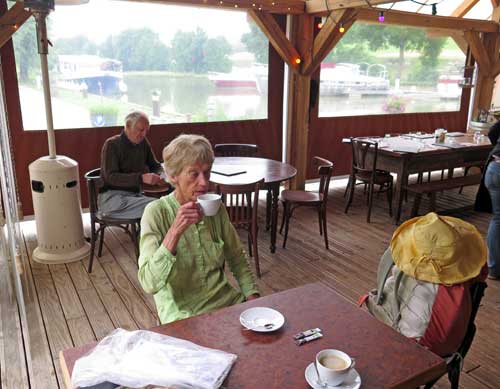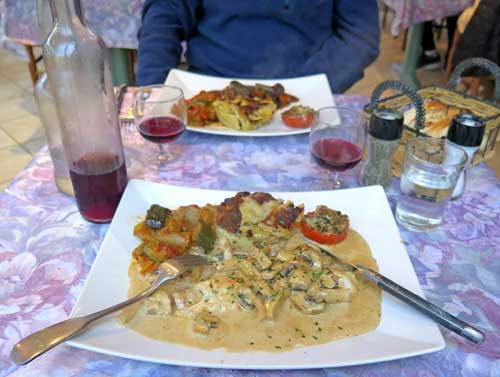Saturday, 1 July 2017
Distance 28 km
Duration 6 hours 15 minutes
Ascent 230 m, descent 165 m
Map 136 of the
Much as we had enjoyed the sound of rain on the tent during the night, we were pleased that it had stopped by morning.
Outside, the rainwater had already been absorbed into the ground, leaving everything green and fresh, but not waterlogged.
We packed up and left before

Half an hour on the towpath brought us to the gaily painted lock of le Banet, which also served as a little cafe.
Our hopes rose for an instant until we saw that it did not open until

Pressing on, we passed several other locks of the normal sort, and the canal became more and more sinuous as the wooded hills closed in on either side.
The weather had reverted somewhat, and we had to hurriedly put on our rain capes a couple of times, although only briefly.


We were getting a bit tired and disheartened by the time we got to the lock of la Bussière with its little boat harbour. There was supposed to be a bar in the village above (La Forge), but we had learned not to trust such fantasies until we saw the real thing. Nevertheless we went to look for it.
To our great joy, it did exist, with the lights on, the door open, and customers inside. The customers were all dressed in black, which seemed strange, but it turned out that they were on their way to a funeral and were fortifying themselves with a round of stiff drinks.
We stuck to coffee, which was delicious after almost three hours of walking, and a plate of pastries – a croissant, a pain au chocolat, a chausson and a pain aux raisins. We sat inside, as the weather was still cool and damp.
Much improved in both body and spirit, we strode off again along the canal.
We only had six or seven kilometres to go before we reached the big bend of the Pont d’Ouche, where the canal leaves the valley of the Ouche and turns comprehensively north again.

We had been here before, and had followed the canal north from here to Tonnere, taking the best part of six days.
This time our intention was different – we would abandon the canal and follow the Ouche southward to Bligny, then branch off in the general direction of the Atlantic Ocean.

The bar at the boat harbour was open, with its plastic curtains lowered against the showers, so we had another round of coffee there.
It was almost noon by the time we rose from this pleasant pause. Although we had walked from Bligny to Pont d’Ouche last time, we had gone on the road, as it had been such a rainy day.
This time we resolved to follow the marked walking track, which left the bitumen at the village of Thorey, about half an hour from the Pont d’Ouche.
From there, the first part of the walking track was an alarmingly steep little road out of the village – alarming at least to people who had spent the last ten days strolling along totally flat river banks and canal paths.
We passed a few antiquated houses clinging to the slope, then an open meadow. Rain clouds were chasing us up the hill, and even sent down a few drops before we plunged into a dense, overarching birch forest.

The track was wide and easy to follow, and we began to suspect that it had formerly been a main thoroughfare.
This suspicion was strengthened when we came to a line of mossy stone markers, spaced about 100 m or so apart, engraved with the numbers 200, 199, 198, 197 and then no more – possibly because at that point our track turned and began to descend.

A couple of sharp bends later we emerged from the trees and saw the village of Bligny laid out at our feet. We remembered it from last time – the Mairie with its tall clock tower and the red-roofed cottages resting in their cradle of hills.
By the time we got to the main square it was after 2 pm, but we stopped at the hotel-restaurant (le Val d’Ouche), where a few diners were still happily working their way through the lunch menu, to make sure that we could get a meal there in the evening.

Last time we were here, they had been closed, and we had been obliged to make do with pizzas from a van.
There was no difficulty this year, so we booked a table for

As before, the grounds of the camping area were meticulously clean and tidy, with soft lawns, spreading trees, flower beds and picnic tables.
There were several other tents and caravans set up, but on such a spacious site our neighbours were all far away and we did not get beyond a few pleasantries at the shower block.
The afternoon was cool, so we had a rest inside the tent, and wore our warm garments when we went back to town.
Before presenting ourselves at the restaurant we had an apéritif at the bar across the street, which was full of locals.
They were a rough and ready lot, very curious about our native land, which they seemed to regard as an almost mythical country.
The only thing they knew about Australia was that we were very harsh on refugees, a policy which they approved of, although we told them we did not. There was a move to buy a second round of drinks for us, but we smilingly declined, and left, amid many protestations of friendship.
The hotel restaurant had a much more dignified atmosphere, although it was already well occupied with other diners.
We began with slices of pork and herb terrine, an unlikely colour combination of pink and green, but deliciously flavoursome. We demolished a basket of bread and half the wine with this.

Our main courses recalled the wonderful dinner at the château a week ago – boeuf bourgignon for Keith and chicken in cream for me.
Once again, both were excellent, the more so for the ratatouille, stuffed tomato and gratin dauphinois that came with them.

Before leaving, we checked that the bar would be open in the morning for breakfast. Years of unpleasant surprises had made us cautious about such things.
At the camping ground, the municipal officer had arrived and we paid our dues – the grand sum of €8.40.
Previous day: Dijon to Ste-Marie-sur-Ouche




